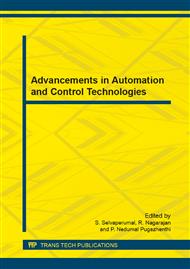p.72
p.78
p.83
p.89
p.95
p.102
p.108
p.115
p.122
New Cost Effective Inverter Fed BLDC Motor for Electric Vehicle Applications
Abstract:
The main work of this paper is to control the speed of a four switch inverter fed three phas s Brushless DC motor drive based on the concept of switching functions. The advantage of this inverter that uses of four switches instead of using six switches are lesser switching losses, lower electromagnetic interference (EMI), less complexity of control algorithms and reduced interface circuits. This drive system consists of a Buck Boost converter, four switch inverter and BLDC motor. Here current and torque ripples could be reduced based on controlled dc link voltage according to the motor speed. This proposed scheme is compared with conventional BLDC motor drive system. Simulation and Experimental works are carried out and results presented to demonstrate the feasibility of the proposed four switch inverter method.
Info:
Periodical:
Pages:
95-101
Citation:
Online since:
June 2014
Authors:
Price:
Сopyright:
© 2014 Trans Tech Publications Ltd. All Rights Reserved
Share:
Citation:


